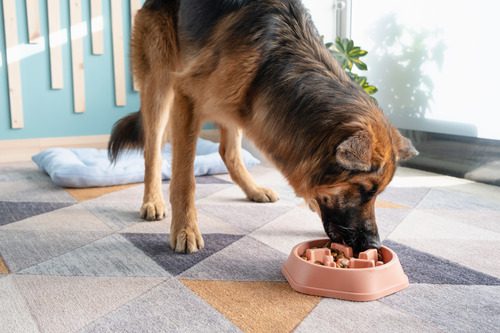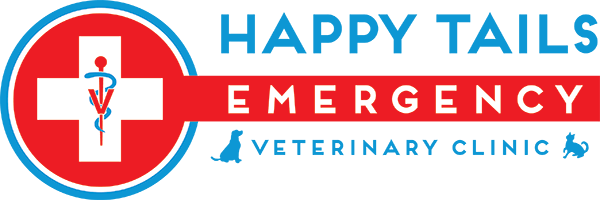Bloat in Dogs: Common Causes and How It’s Treated

Imagine this: you’re enjoying a quiet afternoon with your dog, when suddenly, they start pacing around, drooling excessively, and seem unable to settle down. Their stomach looks unusually swollen, and they’re trying to vomit but nothing comes up. In that moment, panic sets in as you realize something’s wrong, but what is it? This could very well be bloat, a life-threatening condition that requires immediate attention. In this blog, we’ll explore everything you need to know about bloat in dogs, from common causes to treatment options, so you’re prepared if it ever happens to your pet.
What is Bloat in Dogs?
Bloat is a serious condition that occurs when a dog’s stomach fills with gas, food, or fluid, causing the stomach to expand. In severe cases, the stomach can rotate, cutting off blood flow to the stomach and other vital organs, which leads to a condition called gastric torsion. This is a medical emergency that requires swift action. The causes of bloat are not always fully understood, but several factors are known to increase the risk.
Common Causes of Bloat in Dogs
Understanding the causes of bloat can help you identify potential risk factors and better care for your dog.
Large and Deep-Chested Breeds
Dogs with deep, narrow chests are more susceptible to bloat. Breeds like Great Danes, Doberman Pinschers, and Saint Bernards are at higher risk due to the shape of their bodies. Their stomachs have more room to expand, which can increase the likelihood of bloat occurring.
Rapid Eating or Drinking
Dogs that eat or drink too quickly are more prone to bloat. Rapid eating or drinking increases the chance of swallowing air, which can contribute to the buildup of gas in the stomach. Using slow-feed bowls or training your dog to eat more slowly can help reduce this risk.
Stress and Anxiety
Stressful situations, such as a sudden change in routine or environment, can contribute to bloat. Anxiety can cause your dog to eat too fast or drink too much, both of which can increase the chances of bloat.
Exercise After Meals
Engaging in vigorous exercise immediately after eating can increase the risk of bloat. When dogs are active too soon after eating, their stomachs may become unsettled, leading to bloat. It’s important to allow your dog time to rest and digest after meals before playing or exercising.
Underlying Medical Conditions
Some medical conditions, like gastric ulcers, may increase a dog’s risk of developing bloat. Certain infections or hormonal imbalances can also contribute to the condition.
Recognizing the Symptoms of Bloat in Dogs
Recognizing the symptoms of bloat can help you act quickly to get your dog the treatment they need. If you suspect bloat, it’s crucial to get your dog to the veterinary clinic as soon as possible.
Distended Abdomen
One of the most obvious signs of bloat in dogs is a swollen or distended abdomen. The belly may look tight or hard to the touch, and your dog may appear uncomfortable or even in pain.
Excessive Drooling
Excessive drooling, also known as hypersalivation, is another common symptom of bloat. This can occur because the dog is unable to swallow properly due to the pressure in the stomach.
Retching Without Vomiting
Dogs with bloat may attempt to vomit but are unable to bring anything up. This dry heaving or retching is a classic sign of the condition and should not be ignored.
Lethargy and Weakness
Bloat can lead to a sudden drop in blood pressure, causing your dog to become weak and lethargic. They may seem disoriented, refuse to stand, or collapse due to the lack of oxygen circulating to their organs.
Restlessness
If your dog is pacing or showing signs of anxiety, it could be a sign that they’re in pain. Dogs with bloat may try to move around to find a comfortable position, but their discomfort can prevent them from settling down.
How is Bloat Diagnosed in Dogs?
If you notice any of the symptoms listed above, it’s important to contact a veterinarian immediately. Your vet will diagnose bloat through a combination of a physical examination, your dog’s medical history, and diagnostic tests like X-rays. These tests allow the vet to confirm whether your dog’s stomach is distended or rotated, which is critical for determining the appropriate treatment.
What Is the Treatment for Bloat in Dogs?
Once bloat is diagnosed, prompt treatment is crucial to save your dog’s life. The treatment plan will depend on the severity of the condition and whether the stomach has twisted.
Stabilizing Your Dog
The first step in treating bloat is stabilizing your dog’s condition. This may involve intravenous fluids to combat shock, as well as oxygen therapy to support breathing. Your vet will also work to decompress the stomach by inserting a needle or tube to release the gas or fluid buildup.
Surgery
If your dog’s stomach has twisted, surgery is usually required to untwist the stomach and reposition it properly. In some cases, a procedure called gastropexy may be performed to attach the stomach to the abdominal wall, reducing the chances of bloat occurring again in the future.
Monitoring and Recovery
After surgery or treatment, your dog will be monitored closely for any complications. Most dogs will need to stay at the clinic for several days to recover and ensure that their condition improves. It’s important to follow your vet’s instructions carefully during recovery to help prevent future episodes of bloat.
Tips for Preventing Bloat in Dogs
While bloat can happen to any dog, there are steps you can take to reduce the risk of it occurring.
- Slow Down Their Eating: To help prevent bloat, use slow-feed bowls or puzzle feeders to encourage your dog to eat more slowly. This reduces the amount of air swallowed during meals.
- Feed Smaller, More Frequent Meals: Instead of feeding your dog one large meal, consider splitting their food into smaller, more frequent meals throughout the day. This can help ease the strain on their stomach and reduce the likelihood of bloat.
- Limit Exercise After Meals: Avoid vigorous exercise immediately after meals. Allow your dog to rest for at least an hour after eating before engaging in any strenuous activity.
- Manage Stress: Providing a calm environment, especially during mealtime, can help minimize stress-related behaviors.
- Consider Surgery for High-Risk Dogs: If you have a breed that is particularly prone to bloat, your vet may recommend preventive surgery, such as gastropexy, especially if your dog has experienced bloat in the past.
Act Quickly if You Suspect Bloat in Your Dog
Bloat is a life-threatening condition, and time is of the essence. If you suspect your dog may have bloat, call your Greensboro veterinarian immediately at (336) 288-2688. Early intervention can be the difference between life and death for your dog, so it’s always better to err on the side of caution. By understanding the causes, symptoms, and treatment options for bloat in dogs, you can act quickly to protect your pet’s health. Always stay vigilant, and never hesitate to contact Happy Tails Emergency Veterinary Clinic if you have concerns.
Recent Posts
About Us
At Happy Tails Veterinary Emergency Clinic in Greensboro, NC, our kind and knowledgeable team is available to provide gold standard emergency vet care for you and your pet. We’re available in the late night and early morning hours during the week, and 24/7 on weekends for your convenience.
